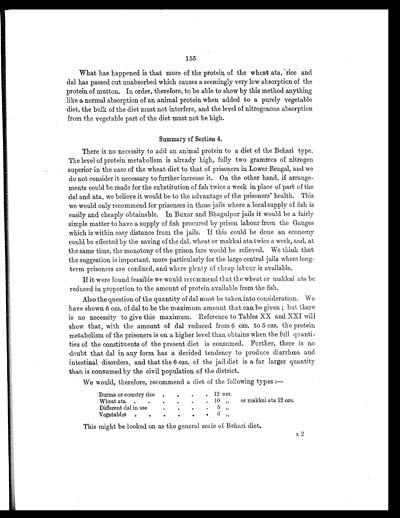Medicine - Institutions > Army health reports and medical documents > Scientific memoirs by officers of the Medical and Sanitary Departments of the Government of India > Number 37 - Investigations on Bengal jail dietaries > Part I > Chapter II - Nutritive value of Bengal jail dietaries
(165) Page 155
Download files
Individual page:
Thumbnail gallery: Grid view | List view

155
What has happened is that more of the protein of the wheat ata, rice and
dal has passed out unabsorbed which causes a seemingly very low absorption of the
protein of mutton. In order, therefore, to be able to show by this method anything
like a normal absorption of an animal protein when added to a purely vegetable
diet, the bulk of the diet must not interfere, and the level of nitrogenous absorption
from the vegetable part of the diet must not be high.
Summary of Section 4.
There is no necessity to add an animal protein to a diet of the Behari type.
The level of protein metabolism is already high, fully two grammes of nitrogen
superior in the case of the wheat diet to that of prisoners in Lower Bengal, and we
do not consider it necessary to further increase it. On the other hand, if arrange-
ments could be made for the substitution of fish twice a week in place of part of the
dal and ata, we believe it would be to the advantage of the prisoners' health. This
we would only recommend for prisoners in those jails where a local supply of fish is
easily and cheaply obtainable. In Buxar and Bhagulpur jails it would be a fairly
simple matter to have a supply of fish procured by prison labour from the Ganges
which is within easy distance from the jails. If this could be done an economy
could be effected by the saving of the dal, wheat or makkai ata twice a week, and, at
the same time, the monotony of the prison fare would be relieved. We think that
the suggestion is important, more particularly for the large central jails where long-
term prisoners are confined, and where plenty of cheap labour is available.
If it were found feasible we would recommend that the wheat or makkai ata be
reduced in proportion to the amount of protein available from the fish.
Also the question of the quantity of dal must be taken into consideration. We
have shown 6 ozs. of dal to be the maximum amount that can be given; but there
is no necessity to give this maximum. Reference to Tables XX and XXI will
show that, with the amount of dal reduced from 6 ozs. to 5 ozs. the protein
metabolism of the prisoners is on a higher level than obtains when the full quanti-
ties of the constituents of the present diet is consumed. Further, there is no
doubt that dal in any form has a decided tendency to produce diarrhœa and
intestinal disorders, and that the 6 ozs. of the jail diet is a far larger quantity
than is consumed by the civil population of the district.
We would, therefore, recommend a diet of the following types:—
| Burma or country rice | 12 | ozs. | |||||||
| Wheat ata | 10 | „ | or makkai ata 12 ozs. | ||||||
| Different dal in use | 5 | „ | |||||||
| Vegetables | 6 | „ | |||||||
This might be looked on as the general scale of Behari diet.
X 2
Set display mode to: Large image | Zoom image | Transcription
Images and transcriptions on this page, including medium image downloads, may be used under the Creative Commons Attribution 4.0 International Licence unless otherwise stated. ![]()
| Permanent URL | https://digital.nls.uk/75033210 |
|---|




